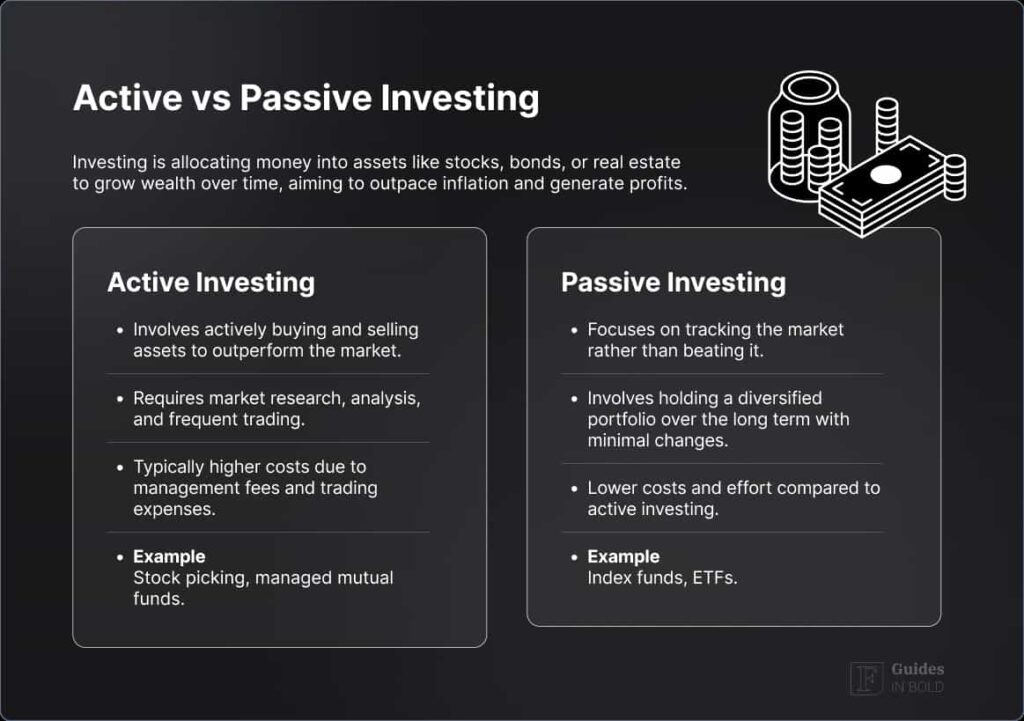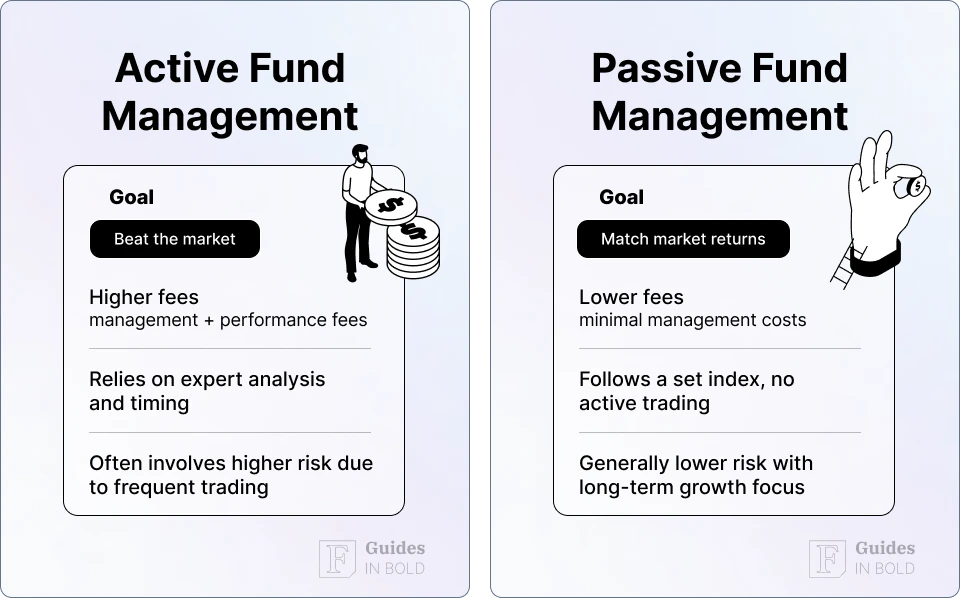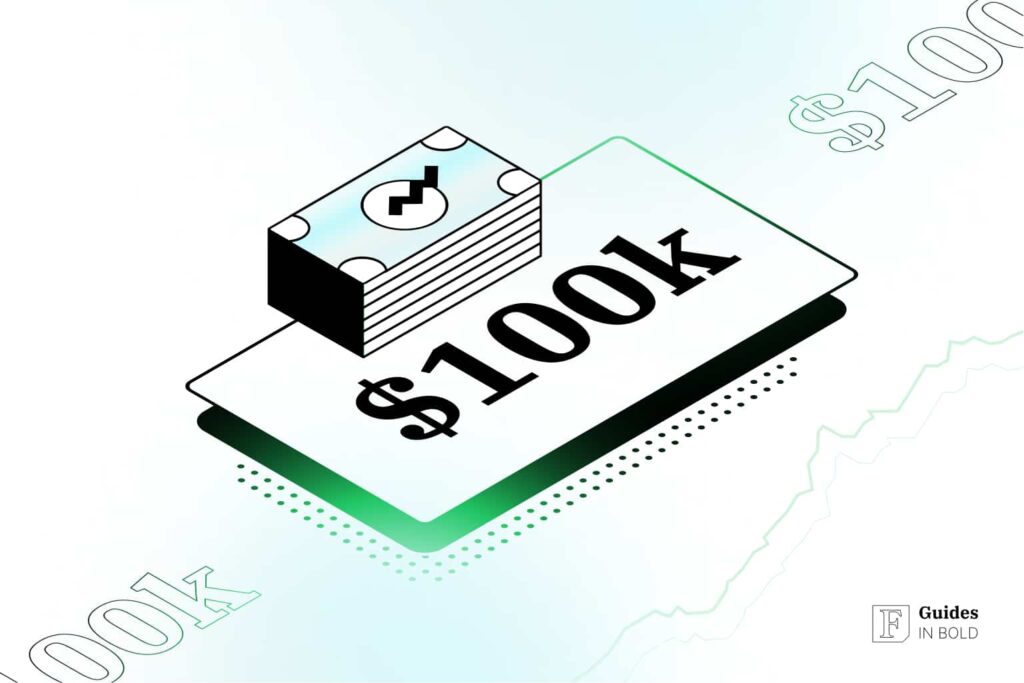If you’ve managed to save $100k, you have a solid head start on building your net worth. However, to cover all your investing goals, it will take some savvy investing skills as well as a disciplined approach to saving.
In this guide, you will find ideas for how to invest $100k, the pros and cons of those methods, what to consider before you start investing, as well as more conservative strategies for saving for retirement.
Highly Rated Stock Trading & Investing Platform
-
Invest in stocks, ETFs, options and crypto
-
Copy top-performing crypto-traders in real time, automatically.
-
0% commission on buying stocks - buy in bulk or just a fraction from as little as $10. Other fees apply. For more information, visit etoro.com/trading/fees.
-
eToro USA is registered with FINRA for securities trading.
What kind of investor are you?
Before you decide how to invest that $100k, ask yourself these questions:
- What is my investing goal? Is it to save for an upcoming expense, such as a car or a down payment for a house, or are you saving for retirement? This is important because a short-term goal will require a different approach to a long-term goal;
- What is my risk tolerance? Investing is inherently risky, and your risk tolerance will determine your asset allocation;
- How much do I want to be involved? $100k is a substantial amount of money, and investing it can seem daunting. Therefore, you might want to take a more hands-off approach and consider getting help from a financial advisor.
Ultimately, your age, risk tolerance, investment time horizon, and financial goals all factor into your investment style. And understanding who you are as an investor can help you adjust your method as you age and your financial goals change.
Before we proceed further
Where to invest $100k: 3 best ways
Here is an unusual problem: you happen to have an extra $100k on hand but don’t know what to do with it. And while there is no perfect way to use this cash, there are various options. Ultimately, your goal in finding the best way to invest $100k is to choose the financial instrument (or combination of instruments) that is right for you.
Below you will find some considerations on where to park your money, including our pick for the three best ways to invest $100k:
Now, let’s dive deeper.
1. Buying individual stocks
In this section: How to invest $100k in the stock market?
Investment type: Long-term growth
Risk Level: Varies
Broker to consider: Regulated, secure platform eToro.
Highly Rated Stock Trading & Investing Platform
-
Invest in stocks, ETFs, options and crypto
-
Copy top-performing crypto-traders in real time, automatically.
-
0% commission on buying stocks - buy in bulk or just a fraction from as little as $10. Other fees apply. For more information, visit etoro.com/trading/fees.
-
eToro USA is registered with FINRA for securities trading.
Disciplined investing in the stock market over decades is generally the best way to build long-term wealth. And though returns can fluctuate from year to year, if investors reinvest their profits, they may even see compounding gains, which only grow more handsome as time passes.
For example, the S&P 500 brought a 26.89% return in 2021 amid the post-pandemic recovery. And even though the benchmark was down a whopping -19.44% in 2022, it’s still averaging 10.21% since its inception in 1957.
So, once you know what industry, sector, or company you want to invest in, you can shop for an investing platform. For the hands-on types, this typically means a brokerage account, such as eToro or Interactive Brokers. However, for those who require more assistance, opening an account through a robo-advisor is a suitable option. Alternatively, hiring a financial planner or investment advisor for stock recommendations might be a wise choice, particularly when a lot of capital is at stake.
Important
Pros and cons of investing in the stock market:

Pros
- High returns: Investing in the stock market can potentially generate higher returns than more conservative asset classes such as bonds;
- Liquidity: Stocks are highly liquid, meaning you can easily buy and sell them at any time;
- Low barrier of entry: Most retail brokers offer commission-free trading and no account minimums, so you can start investing with as little as $10;
- Build long-term wealth: Generally, stocks yield a generous annualized return over the long term. For example, in March of last year, the 10-year annualized return for the S&P 500 was 12.9%. So at the minimum, you’ll be able to stay ahead of inflation.

Cons
- Returns are not guaranteed: While stocks can outperform many financial assets over long periods, they may not do well over your chosen investing period;
- No short-term gains: Generating profits through stocks generally takes decades, not weeks or months;
- Volatility: Share prices rise and fall minute to minute, taking the investor on an emotional rollercoaster. The best is, therefore, to check your investment only periodically;
- Time: When buying individual stocks, you must manage your portfolio yourself. That means regularly following various company health indicators as well as overall market conditions and adapting the asset allocation in your portfolio as necessary. Unfortunately, doing all of that can take a lot of work.
Dividend Investing
2. Index investing
In this section: How to invest $100k in index funds and ETFs?
Investment type: Long-term growth
Risk Level: Varies
Broker to consider: Regulated, industry-leading low-cost trading platform Interactive Brokers.
Best Platform for Worldwide Stock Trading & Investing
-
Highly trusted multi-asset broker with clients in over 200 countries
-
Trade on 150 markets globally from a single platform (stocks, ETFs, futures, currencies, crypto & more)
-
Low commissions starting at $0 with no platform fees or account minimums
-
Easily fund your account and trade assets in 26 currencies
-
IBKR pays up to 4.58% interest on cash balances of $10k or more
Passive investing is a long-term investment strategy for building wealth in which investors buy and hold a diversified portfolio of assets with minimal active trading in the market.

Index investing is the most common form of passive investing. In this buy-and-hold strategy, investors purchase exchange-traded funds (ETFs) or mutual funds that track major market benchmarks, such as the S&P 500 or the Dow Jones Industrial Average and hold it over a long time horizon. The objective is to reproduce the financial index performance overall, to match, not beat, the market.
The three most broadly tracked indexes in the United States are:

Pros and cons of investing in index funds and ETFs:

Pros
- Low costs: The lack of frequent trading means transaction costs (commissions, etc.) are low with a passive strategy. In addition, while management fees charged by funds are unavoidable, most ETFs fees range from as little as 0.05% to about 1%;
- Less risk: Indexing, by its very nature, offers greater diversification, minimizing portfolio risk;
- Tax efficiency: The buy-and-hold method doesn’t generally result in a massive capital gains tax for the year;
- Convenience: Owning an index is far less complicated to manage than a portfolio of individual stocks that require constant research and adjustment;
- Simplicity: Taking a hands-off investment approach can eliminate many of the biases and uncertainties that can arise when you pick stocks individually.

Cons
- Volatility: Index funds follow their benchmark index regardless of the state of the markets, meaning if the market conditions are poor, the index funds will also follow the indexes downward. In this case, a good active manager may be able to limit the downside by hedging the portfolio or moving positions to cash;
- Slow gains: Buying and holding can be a winning tactic in the long haul, but evening out the risks also flattens out the rewards;
- Many index funds are formed on a market capitalization basis: For example, the S&P 500 gives higher weights to companies with more market capitalization. So, if, say, behemoths such as Amazon.com Inc. (NASDAQ: AMZN) and Meta Platforms Inc. (NASDAQ: META) experienced a weak quarter, it would have a significant impact on the entire index.
Note
3. Real estate
In this section: How to invest $100k in real estate and rental properties, REITs?
Investment type: Long-term growth
Risk Level: Medium
In addition to stock market exposure, you might also want to invest in real estate. Here are five methods for adding real estate exposure to your portfolio:
1. Real estate investment trusts (REITs)
REITs are companies that own, operate, or finance income-generating real estate. REITs (as well as REIT mutual funds and REIT ETFs) are publicly traded and can be bought or sold via a brokerage account, making them the most liquid real estate investment available.

Pros and cons of investing in REITs:

Pros
- Pay dividends;
- Highly liquid;
- Diversified;
- Takes the manual work out of owning real estate.

Cons
- Dividends are taxed as regular income;
- Hypersensitive to interest rates.
2. Crowdfunding real estate investing platforms
This method entails pooling money from several investors to fund a real estate project or investment.
Pros and cons of crowdfunding real estate investing platforms:

Pros
- Possibility of investing in specific single projects or a portfolio of projects.

Cons
- Require you to commit for longer periods;
- Management costs.
3. Residential home
Buying your own home (typically by taking out a mortgage) is the most common way most Americans invest in real estate. However, while investing in your home can help you build wealth over the long haul, after property taxes, maintenance costs, and insurance, average annual returns are far less juicy than expected.
Pros and cons of buying your own home:

Pros
- Possibility of appreciation;
- Building home equity;
- Tax deductions and deductible expenses;
- Government support for mortgage buyers.

Cons
- Various costs like maintenance and repairs, insurance, property taxes, and the home loan interest;
- Illiquidity;
- High upfront costs;
- Potential depreciation.
4. Rental properties
Rentals can offer steady cash flow and the possibility of appreciation over time. However, they are one of the most labor-intensive approaches to real estate investing.
Pros and cons of investing in rental properties:

Pros
- Income-generating;
- Properties typically appreciate;
- Many expenses are tax-deductible.

Cons
- Managing tenants and ongoing maintenance costs;
- Vacant properties will result in losses.
5. Flipping properties
Flipping involves purchasing a property not to use but with the intention of selling it for a profit. However, like rental properties, flipping takes lots of work, including renovation work as well as learning to identify up-and-coming neighborhoods that will allow you to sell at a premium.
Pros and cons of flipping properties:

Pros
- Ties up capital for a shorter period;
- Can offer quick returns.

Cons
- Requires substantial experience in real estate valuation, marketing, and renovation;
- High out-of-pocket costs.
How to invest $100k for retirement?
If you just aren’t quite sure yet how and where to invest, here are a few of the safest ways to park your money:
- Savings accounts: Savings accounts, provided by banks and credit unions, offer modest interest rates. Their safety and liquidity make them ideal for holding cash needed for short-term expenses, with FDIC insurance covering up to $250,000 per depositor, per bank;
- High-yield savings accounts: Though the interest rates on high-yield savings accounts can be up to 25 times greater than with traditional savings accounts, they often require a minimum balance, and access to the account is limited;
- Certificate of deposits (CDs): A certificate of deposit (CD) is a fixed-term savings product with FDIC insurance. While funds must stay untouched for the entire term to avoid penalties or lost interest, the trade-off is higher interest, especially for longer periods. Investors with $100k or more can choose a jumbo CD for even higher interest rates;
- Annuities: An annuity, offered by insurance companies, delivers a fixed stream of payments, usually monthly income in retirement. Immediate annuity payouts depend on market conditions and interest rates, but they are not advisable for younger individuals or those with liquidity needs due to withdrawal penalties and illiquid funds;
- Treasury Bonds, Bills, and Notes: Treasuries are government debt instruments allowing investors to lend money to the U.S. government and earn interest. They carry zero default risk, guaranteed by the government, and repay the bond’s face value at maturity, offering various maturity dates and interest payment methods;
- Money market funds: Money market funds are mutual funds investing in liquid, short-term instruments like cash and high-credit-rating debt. Ideal for temporarily placing funds before other investments, they are not suitable for long-term investment strategies;
- Money market deposit accounts (MMDAs): MMDAs offer higher interest rates than traditional savings accounts, as well as check-writing and debit card privileges. These financial vehicles are FDIC-insured and provide a safe place to store your money.
Note
How to safely invest $100k — things to consider
While you may be eager to begin investing your $100k, it’s essential to assess your financial standing as a whole and ensure the following factors are satisfied first:
- High-interest debt is paid off: Ensure you have repaid any high-interest debt before investing. That includes credit card debt and debt from other loans, such as payday loans. For instance, the average credit card interest rate in 2022 was 19.42%, significantly higher than the average annual stock market return. Low-interest debts such as mortgages or auto loans, on the other hand, don’t need to be repaid before you start investing;
- You have an emergency fund: Before investing, prioritize establishing an emergency fund of at least six months’ living expenses in a secure deposit account to cover unforeseen costs like medical bills or job loss. This precautionary measure minimizes the risk of tapping into your investments or resorting to high-interest credit cards and loans;
- Space out your investments: Instead of investing all of your money once, try utilizing a dollar-cost averaging (DCA) strategy, in which the total amount to be invested is divided into periodic purchases of a target asset over a period of time;
- Don’t put all your eggs in one basket: Diversify your investments across different instruments and industries to mitigate large losses and increase the likelihood of meeting financial goals. Adequate risk in your portfolio is crucial for achieving significant returns necessary to fulfill your financial objectives;
- Stay wary of fraud: Beware of sophisticated scams with articulate and financially savvy fraudsters using credible websites and documents. Always conduct thorough research, including checking the company’s financial statements on the SEC‘s EDGAR system and consulting warning signs from the FCA and questions from the SEC before investing.
Note

Highly Rated Stock Trading & Investing Platform
-
Invest in stocks, ETFs, options and crypto
-
Copy top-performing crypto-traders in real time, automatically.
-
0% commission on buying stocks - buy in bulk or just a fraction from as little as $10. Other fees apply. For more information, visit etoro.com/trading/fees.
-
eToro USA is registered with FINRA for securities trading.
Conclusion
As you decide how to invest your $100k, focus on building wealth for the long term. Fortunately, with such a substantial amount of cash at the ready, plenty of options are available, from the stock market to real estate.
However, before you invest, take care of the basics, such as paying off debt, setting up or continuing to fund a retirement plan, and building an emergency fund.
Finally, consider your risk appetite and financial goals and create a solid financial plan before making investment decisions. Chances are, if you invest your $100,000 properly, it won’t be long until you’re researching how to invest $1 million.
Disclaimer: The content on this site should not be considered investment advice. Investing is speculative. When investing, your capital is at risk.
FAQs about how to invest $100k
How to invest $100k?
Your best option for investing $100k is to spread it across various financial assets to minimize risk. This could include stocks, index funds, real estate, as well as more conservative options such as bonds or CDs.
How to invest $100k to make $1 million?
Whether you have a shorter or longer window for growing your $100k to $1 million, it’s essential to diversify your holdings. That said, riskier investments with higher annualized returns, such as stocks or REITs, will probably get you there faster than investments in safer low-yield savings products or government debt instruments.
Where to invest $100k?
Where you invest your $100k will depend on your age, risk tolerance, investment time horizon, and financial goals. However, a well-diversified portfolio will combine several asset classes, which carry different levels of risk.
How to invest $100k for passive income?
There are various options for investing $100k for passive income, including index fund investing, dividend investing, crypto staking, P2P investing, and investing in REITs.
How to invest $100k in real estate?
There are a plethora of methods for adding real estate exposure to your portfolio, including through REITs or crowdfunding real estate investing platforms, as well as by investing in your own residency or rental properties.
Highly Rated Stock Trading & Investing Platform
-
Invest in stocks, ETFs, options and crypto
-
Copy top-performing crypto-traders in real time, automatically.
-
0% commission on buying stocks - buy in bulk or just a fraction from as little as $10. Other fees apply. For more information, visit etoro.com/trading/fees.
-
eToro USA is registered with FINRA for securities trading.





